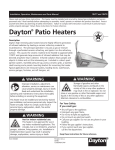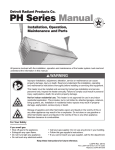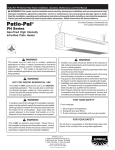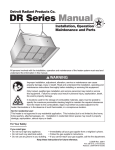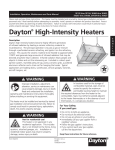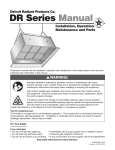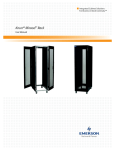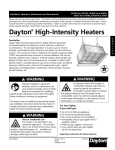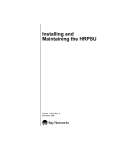Download Dayton 1RVT8 Troubleshooting guide
Transcript
Installation, Operation, Maintenance and Parts Manual 1RVT7 and 1RVT8 Please read and save these instructions. This heater must be installed and serviced by trained gas installation and service personnel only! Read carefully before attempting to assemble, install, operate or maintain the product described. Protect yourself and others by observing all safety information. Failure to comply with instructions could result in personal injury and/or property damage! Retain these instructions for future reference. Dayton Patio Heaters ® Description Dayton high-intensity patio heaters become highly efficient generators of infrared radiation by heating a ceramic refractory material to incandescence. The principal operation is to pass a gas-air mixture through a perforated ceramic refractory, and ignite it on the refractory surface. This causes the ceramic material to be heated to approximately ! large amounts of infrared radiation that may be 1780°F and generate directed anywhere heat is desired. Infrared radiation heats people and objects it strikes and not the intervening air. Included is a direct spark ignition system, manifold pressure tap, porous ceramic grids, a stainless steel housing and a preset mounting bracket for mounting the heater. Typical applications are restaurant patios, loading docks, warehouses, service garages, factories, aircraft hangars, etc. ! WARNING ! Improper installation, adjustment, alteration, service or maintenance can cause property damage, injury or death. Read !and understand the installation, operating and maintenance instructions thoroughly before installing or servicing this equipment. This heater must be installed and serviced by trained gas installation and service personnel only. Inspect the heater annually. Failure to comply could result in personal injury, asphyxiation, death, fire and/or property damage. ! WARNING Not for indoor residential use. This heater is not approved for use in any indoor residential application. This includes, but is not limited to, attached garages, solarium, living quarters, etc. Installation in residential indoor spaces may result in property damage, asphyxiation, serious injury or death. Form 5S5668 ! WARNING Storage of gasoline and other flammable vapors and liquids in the vicinity of this or any other appliance may result in fire or explosion. Do not store or use gasoline or other flammable vapors and liquids in the vicinity of this or any other appliance. Maintain clearance to combustibles. For Your Safety If you smell gas: • Shut off gas to the appliance. • Extinguish any open flame. • Do not try to light any appliance. • Do not touch any electrical switch. • Call your gas supplier. Do not use any phone in your building. • Follow the gas supplier’s instructions. • If you cannot reach your gas supplier, call the fire department. Keep these instructions for future reference. Printed in U.S.A. 03460 1206/346/VCPVP Dayton Installation, Operation, Maintenance and Parts Manual 1RVT7 and 1RVT8 Dayton Patio Heaters ® Safety . . . . . . . . . . . . . . . . . . . . . . . . . . . . . . . . . . . . . . . . . . . . . . . . . . . . . . . . . . . . . . . . . . . . . . 3 Warning Symbols . . . . . . . . . . . . . . . . . . . . . . . . . . . . . . . . . . . . . . . . . . . . . . . . . . . . . . . . .3 Applications . . . . . . . . . . . . . . . . . . . . . . . . . . . . . . . . . . . . . . . . . . . . . . . . . . . . . . . . . . . . .3 Clearance to Combustibles . . . . . . . . . . . . . . . . . . . . . . . . . . . . . . . . . . . . . . . . . . . . . . . . . .4 Standards, Certifications and Government Regulations . . . . . . . . . . . . . . . . . . . . . . . . . . . . .6 Safety Signs and Labels . . . . . . . . . . . . . . . . . . . . . . . . . . . . . . . . . . . . . . . . . . . . . . . . . . . . 7 Installation . . . . . . . . . . . . . . . . . . . . . . . . . . . . . . . . . . . . . . . . . . . . . . . . . . . . . . . . . . . . . . . . . . . . .8 Design . . . . . . . . . . . . . . . . . . . . . . . . . . . . . . . . . . . . . . . . . . . . . . . . . . . . . . . . . . . . . . . . 8 Heater Dimensions . . . . . . . . . . . . . . . . . . . . . . . . . . . . . . . . . . . . . . . . . . . . . . . . . . . . . . . .9 Heater Mounting . . . . . . . . . . . . . . . . . . . . . . . . . . . . . . . . . . . . . . . . . . . . . . . . . . . . . . . .10 Gas Supply . . . . . . . . . . . . . . . . . . . . . . . . . . . . . . . . . . . . . . . . . . . . . . . . . . . . . . . . . . . . . 13 Electrical Requirements . . . . . . . . . . . . . . . . . . . . . . . . . . . . . . . . . . . . . . . . . . . . . . . . . . . 16 Ventilation . . . . . . . . . . . . . . . . . . . . . . . . . . . . . . . . . . . . . . . . . . . . . . . . . . . . . . . . . . . . . 17 Operation . . . . . . . . . . . . . . . . . . . . . . . . . . . . . . . . . . . . . . . . . . . . . . . . . . . . . . . . . . . . . . . . . . . . . 18 Sequence of Operation . . . . . . . . . . . . . . . . . . . . . . . . . . . . . . . . . . . . . . . . . . . . . . . . . . . 18 Wiring Diagrams . . . . . . . . . . . . . . . . . . . . . . . . . . . . . . . . . . . . . . . . . . . . . . . . . . . . . . . . 19 Maintenance . . . . . . . . . . . . . . . . . . . . . . . . . . . . . . . . . . . . . . . . . . . . . . . . . . . . . . . . . . . . . . . . . . 20 Periodic Maintenance . . . . . . . . . . . . . . . . . . . . . . . . . . . . . . . . . . . . . . . . . . . . . . . . . . . . .20 Troubleshooting Guide . . . . . . . . . . . . . . . . . . . . . . . . . . . . . . . . . . . . . . . . . . . . . . . . . . . . 21 Parts . . . . . . . . . . . . . . . . . . . . . . . . . . . . . . . . . . . . . . . . . . . . . . . . . . . . . . . . . . . . . . . . . . . . . 22 Limited Warranty . . . . . . . . . . . . . . . . . . . . . . . . . . . . . . . . . . . . . . . . . . . . . . . . . . . . . . . . . . . . . . .24 2 ! Dayton Installation, Operation, Maintenance and Parts Manual Models 1RVT7 and 1RVT8 Safety ! WARNING Improper installation, adjustment, alteration, service or maintenance can cause property damage, serious injury or death. Read and understand, the installation, operating and maintenance instructions thoroughly before installing or servicing this equipment. Only trained, qualified gas installation and service personnel may install or service this equipment. ! Warning Symbols Applications Safety is the most important consideration during installation, operation and maintenance of the infra-red heater. You will see the following symbols and signal words when there is a hazard related to safety or property damage. ! This is not an explosion proof heater. Consult your local Fire Marshall, insurance carrier and other authorities for approval of the proposed installation. Commercial / Industrial Infrared heaters are designed and certified for use in industrial and commercial buildings such as outdoor restaurant patios, warehouses, manufacturing plants, aircraft hangars and vehicle maintenance shops. For maximum safety, the building must be evaluated for potential hazards before installing the heater system. A critical safety factor to consider before installation is the clearance to combustibles. WARNING Warning indicates a potentially hazardous situation which, if not avoided, could result in death or injury. ! ! CAUTION Outdoor Residential This heater may only be used in outdoor residential applications and is NOT approved for use in any indoor residential application. This includes, but not limited to, attached garages, living quarters, solarium, etc. Consult the local fire marshal and/or insurance provider if unsure of your application. Caution indicates a potentially hazardous situation which, if not avoided, could result in minor or moderate injury. NOTICE Notice indicates a potentially hazardous situation which, if not avoided, could result in property damage. ! WARNING Not For Indoor Residential Use. Installation of a infra-red heater system in residential indoor spaces may result in property damage, serious injury or death. In residential applications this heater may only be used outdoors. 3 ! 1RVT7 and 1RVT8 Dayton Installation, Operation, Maintenance and Parts Manual Dayton Patio Heaters ® Clearance to Combustibles ! WARNING ! Signs shall be posted specifying the maximum permissible stacking height in order to maintain clearances to combustibles. Improperly connected gas lines may result in serious injury or death, explosion, poisonous fumes, toxic gases, asphyxiation. Connect gas lines in accordance to national, state, provincial and local codes. A critical safety factor to consider before installation is the clearances to combustibles. Clearance to combustibles is defined as the minimum distance you must have between the infra-red surface, or reflector, and the combustible item. Considerations must also be made for moving objects around the infra-red heater. The following is a partial list of items to maintain clearances from: Placement of explosive objects, flammable objects, liquids and vapors close to the heater may result in explosion, fire, property damage, serious injury or death. Do not store, or use, explosive objects, liquids and vapor in the vicinity the heater. Failure to comply with the published clearances to combustibles could result in personal injury, death and/or property damage. Combustible items include : • • • • • Hazards Include: Wood Paper Fabric Chemicals Wall or roof insulation Moving objects include: For maximum safety the building must be evaluated for hazards before installing the heater system. Examples include, but not limited to: • • • • • • • • • • • • • • CAUTION • • • • • Gas and electrical lines Combustible and explosive materials Chemical storage areas Areas of high chemical fume concentrations Provisions for accessibility to the heater Adequate clearances around air openings Combustion and ventilating air supply Vehicle parking areas Vehicles with lifts or cranes Storage areas with stacked materials Lights Sprinkler heads Overhead doors and tracks Dirty, contaminated environment Overhead doors Vehicle lifts Cranes Hoists Car wash equipment When installing the infra-red heater system, the minimum clearances to combustibles must be maintained. These distances are shown in Chart 1.1 and on the minimum clearance to combustibles label (F/N: LLPCL002) found on the heater. If you are unsure of the potential hazards, consult your local fire marshall, fire insurance carrier or other qualified authorities on the installation of gas fired infra-red heaters for approval of the proposed installation. 4 Dayton Installation, Operation, Maintenance and Parts Manual Models 1RVT7 and 1RVT8 Chart 1.1 - Clearance to Combustibles in Inches (see Figure 1.1) Model No. Mounting Angle* Sides Back Top Below End(s) Front 0° 14 N/A 13 46 22 N/A 30° N/A 8 17 46 22 46 0° 14 N/A 13 46 22 N/A 30° N/A 8 17 46 22 46 1RVT7 34,000 [Natural Gas] 1RVT8 34,000 [LP Gas] *Heaters mounted on an angle between 0° to 30° must maintain clearances posted for 0° or 30°; whichever is greater. Certain applications (awnings, fabrics, plastics, sprinklers, insulation) may require the heater to be mounted at a distance in excess of the published clearances to combustibles. Contact the factory. Important! If the heater is mounted beneath a noncombustible surface an 8 in. minimum top clearance must be maintained from the top of the heater to prevent overheating the controls. Figure 1.1 - Clearance to Combustibles Clearance to combustible distances represent a surface temperature of 90°F (32°C) above an ambient temperature. Top (to ceiling) Top (to ceiling) Back Side Side Front 30˚ Inlet side down Below Below END VIEW 0° MOUNTING ANGLE END VIEW 30° MOUNTING ANGLE End End SIDE VIEW 5 1RVT7 and 1RVT8 Dayton Installation, Operation, Maintenance and Parts Manual Dayton Patio Heaters ® Standards, Certifications and Government Regulations The installation of this heater must comply with all applicable local, state and national specifications, regulations and building codes (contact the local building inspector and/or fire marshall for guidance) before installing the heater system. In the absence of local codes, the installation must conform to the latest edition of the National Fuel Code ANSI Z223.1 (NFPA 54). Refer to the following Standards and codes for application specific guidelines: Public Garages: The installation of this heater in public garages must conform with the Standard for Parking Structures, ANSI/NFPA 88A (latest edition), or the Standard for Repair Garages, ANSI/NFPA 88B (latest edition) and must be at least 8 ft. above the floor. Electrical: The heater, when installed, must be electrically grounded in accordance with the National Electrical Code ANSI/NFPA 70 (latest edition). Under no circumstances is either the electrical supply line or gas supply line to provide any assistance in the suspension of the heater. Aircraft Hangars: The installation of this heater in aircraft hangars must conform with the Standard for Aircraft Hangars, ANSI/ NFPA 409 (latest edition). The heater must be installed at least 10 ft. above the upper wing surfaces and engine enclosures of the highest aircraft which might be stored in the hangar. In areas adjoining the aircraft storage area, the heaters must be installed at least 8 ft. above the floor. The heaters must be located in areas where they will not be subject to damage by aircraft, cranes, moveable scaffolding or other objects. Ventilation: This heater must be installed in accordance with the requirements set forth in this manual and with the NFPA 54/ANSI Z223.1 National Fuel Gas Code (latest edition). See ventilation requirements on page 17. Dayton® units comply or are certified by one or more of the following organizations or standards: • CSA International Requirement (CSA 2.37). • American National Standards Institute (ANSI Z83.26). High Altitude: The installation of this heater is approved, without modifications, for elevations up to 6,000 ft. MSL (sea level). Contact Dayton for installations above these elevations. • American National Standards Institute (ANSI Z83.19). 6 Dayton Installation, Operation, Maintenance and Parts Manual Models 1RVT7 and 1RVT8 Safety Signs and Labels Safety warning labels must be maintained on the infrared heater. Illustrations of the safety labels, and their locations, are pictured below. In locations used for the storage of combustible materials, signs must be posted to specify the maximum permissible stacking height to maintain the required clearances from the heater to combustibles. Signs must either be posted adjacent to the heater thermostats or in the absence of such thermostats in a prominent location. It is important to provide warnings to alert individuals to potential hazards and safety actions. ANSI Z83.26/CSA 2.37 require you to post a sign “specifying the maximum permissible stacking height to maintain the required clearances from the heater to the combustibles” near the heaters thermostat or in absence of such thermostats in a conspicuous location. WARNING DO NOT ROTATE CONTROL ASSEMBLY USE TWO WRENCHES TO TIGHTEN OBSERVE PROPER GAS FOR GAS TYPE ONLY F/N: LL02 - Observe Proper Gas Type (Natural Gas) F/N: LL03 - Observe Proper Gas Type (LP Gas) Top Panel ! DANGER FIRE HAZARD. Always maintain published clearance to combustibles. In locations used for the storage of combustible materials, signs must be posted. Consult manual for additional guidelines. CLEARANCE TO COMBUSTIBLES MODEL NO. ALL MODELS (in inches) ALL MODELS ! WARNING AVOID SERIOUS INJURY, DEATH OR PROPERTY DAMAGE. (in millimeters) MOUNTING ANGLE 0° END(S) 22” SIDE(S) 14” BELOW 46” TOP 13” BEHIND N/A 30° 0° 22” 559mm N/A 356mm 46” 1168mm 17” 330mm 8” N/A 46” N/A 30° 559mm N/A 1168mm 432mm 203mm 1168mm SIDE VIEW END VIEW 0° Mounting FRONT N/A END VIEW 30° Mounting Maintain Clearances to Combustibles to Prevent the Risk of Fire. Clearances to combustibles must be maintained in order to prevent the ignition of combustible materials. In locations used for the storage of combustible materials, signs must be posted to specify the maximum permissible stacking height to maintain the required clearances from the heater to the combustibles. Signs must either be posted adjacent to the heater thermostats or in the absence of such thermostats in a conspicuous location. Clearances are provided on the heater’s safety labels and in the heater’s Installation & Operation Manual. Refer to applicable ANSI or NFPA-54 Standards or local codes for further information. Post this tag adjacent to the heater’s thermostat or controls before operating the heater. INSTALLER. READ AND POST THIS NOTICE. F/N: LL01 - Clearance Safety Tag (Affix adjacent to heater’s thermostat). 30° The minimum end clearance is 22” or 559mm. Avoid Serious Injury or Death. Improper installation, adjustment, alteration, service or maintenance can cause property damage, injury or death. Read the installation, operation and maintenance manual thoroughly before installing or servicing this equipment. This is not an explosion-proof heater. Where there is the possibility of flammable vapors or dusts, consult the local fire marshal, fire insurance carrier or other authorities for approval of the proposed installation. Always maintain minimum ventilation requirements. This side down Contact may cause burn. Do NOT touch hot surface. Allow to cool before servicing. This heater must be installed by qualified personnel only and in accordance with the latest edition of the ANSI/NFPA Standards. (ANSI/NFPA 88A Parking Structures), 88B (Repair Garages), 409 (Aircraft Hangars). Observe all country, state and local codes. LIGHTING INSTRUCTIONS 1. Rotate heater’s valve knob to “ON” position. 2. Close electrical circuit (usually thermostat). 3. If the heater fails to light, turn “OFF” gas, open electrical circuit and wait 5 minutes before repeating. F/N: LLPCL002 Patio Heater Clearance to Combustibles Label 7 1RVT7 and 1RVT8 Dayton Installation, Operation, Maintenance and Parts Manual Dayton Patio Heaters ® Installation ! WARNING Read and understand, the installation, operating and maintenance instructions thoroughly before installing or servicing this equipment. ! CAUTION This heater cannot be used in a building with a roof that is not insulated or where condensation problems can occur. Only trained, qualified gas installation and service personnel may install or service this equipment. Design To ensure a safe, properly designed heating system, a layout should be developed for the correct placement of the infra-red heater(s). Aside from safety factors such as clearance to combustibles (see Chart 1.1 on page 5), you should take into consideration: • The environment (e.g., is it cold/drafty, average, protected)? Note: The effective infra-red surface temperature of a person or object may be diminished with wind above 5 mph, wind barriers may be required. • What is the area of heat coverage (e.g., sq. ft.) needed (Chart 2.1, Figure 2.2)? • Is the heater being used in a social gathering area, or work station(s)? • The mounting height of the heater (Chart 2.1, Figure 2.3). • The type of mounting to be used. • Physical space needed for the heater (Figure 2.1). This installation manual, along with national, state, provincial and local codes, address these issues. It is critical that you read, understand and follow all guidelines and instructions. Always inspect and evaluate the mounting conditions, space for exhaust, gas supply and wiring. IMPORTANT: Fire sprinkler heads must be located at an appropriate distance from the heater. This distance may exceed the published clearance to combustibles. Certain applications will require the use of high temperature sprinkler heads or relocation of the heaters. Potentially flammable substances, such as Propylene Glycol or antifreeze solutions, are not to be used in conjunction with this heater. For further information consult NFPA 13. Always observe applicable state and local codes. • Gas supply and connections. • Combustion, ventilating air supply and exhaust path. • Electricity and wiring to the heater. 8 Dayton Installation, Operation, Maintenance and Parts Manual Models 1RVT7 and 1RVT8 Figure 2.1 - Patio Heater Dimensions 8.5” 9” 45” END VIEW SIDE VIEW Figure 2.2 - Mounting Bracket Extension Dimensions The heater’s mounting brackets are adjustable in one inch intervals when installed with the connecting arms. All clearance to combustibles must be maintained. Refer to the minimum and maximum mounting bracket extensions below. 1. Minimum mounting bracket extension to non-combustibles only is 9 in. 2. Minimum 0° mounting bracket extension to combustibles is 14.5 in. 3. Minimum angle mounting bracket extension (up to 30°) to combustibles is 17.5 in. 4. Maximum mounting bracket extension is 20.5 in. 1 2 3 9 4 1RVT7 and 1RVT8 Dayton Installation, Operation, Maintenance and Parts Manual Dayton Patio Heaters ® Heater Mounting ! WARNING Improper suspension of the infrared heater may result in collapse and persons being crushed. Always suspend from a permanent part of the building structure that can support the total force and weight of the heater. Failure to maintain minimum clearance to combustibles may result in fire and/or explosion, property damage, serious injury or death. Always maintain minimum clearances and post signs or provided tags (F/N: LL01) where needed. Signs should state the hazards for the particular application and be legible for the building occupants. Consult the factory or a factory representative for additional information on signage compliance. The heater can be suspended with chains or rigid threaded rod. Local codes, or conditions such as wind drafts or other variables can cause movement of the heater and may require rigid threaded rod. Avoid excessive movement and/or vibration of the gas connection by rigidly mounting the heater. The heater mounting brackets can be used in place of rigid threaded rods (see Figures 2.5 - 2.6). Consult all applicable codes before installation. The heater must be level from side to side and can be set at an angle between 0° and 30° from horizontal. The gas connection and power cord must be located on the lower side (see Figure 2.4). Figure 2.4 - Heater Orientation Mounting bracket 30° End End Level end to end The gas connection and power cord must located towards the lower side of the heater (towards the floor). 10 Dayton Installation, Operation, Maintenance and Parts Manual Models 1RVT7 and 1RVT8 Chart 2.1 - Recommended Mounting Heights Model & Input 1RVT7, 1RVT8 34,000 BTU/h Recommended Mounting Height (Dimension A) Approximate Coverage Area 8’-6” to 10’-0” 9’ x 9’ Note: This chart is provided as a guideline. Actual conditions dictate variances from this data. Figure 2.3 • Recommended Mounting Heights A 11 1RVT7 and 1RVT8 Dayton Installation, Operation, Maintenance and Parts Manual Dayton Patio Heaters ® Wall Mounting Bracket Figure 2.6 - Typical Side Wall Mounting Your patio heater is equipped with preset mounting hardware. Figures 2.6 and 2.7 illustrate various mounting configurations using the preset mounting bracket. This hardware allows the heater to be installed at an angle between 0° and 30°. This angle must not exceed 30° from horizontal. Mounting bracket attached to wall. Assemble the mounting hardware as shown in figure 2.5. 30° 30° Mounting Angle The mounting hardware is adjustable in one inch intervals using the connecting arms Refer to figure 2.2 on page 9 for an illustration of the minimum and maximum extentions of the mounting bracket. Figure 2.5 - Mounting Bracket Assembly 0° Mounting Angle Figure 2.7 - Typical Ceiling Mounting Mounting bracket attached to ceiling. 30° 0° Mounting Angle 12 30° Mounting Angle Dayton Installation, Operation, Maintenance and Parts Manual Models 1RVT7 and 1RVT8 Gas Supply • Check that the gas piping and service has the capacity to handle the load of all heaters being installed, as well as any other gas appliances being connected to the supply line. WARNING ! • Check that the main gas supply line is of proper diameter to supply the required fuel pressures. Improperly connected gas lines may result in fire, explosion, poisonous fumes, toxic gases, asphyxiation and death. Connect gas lines in accordance to national, state, provincial and local codes. • If utilizing used pipe, verify that its condition is clean and comparable to a new pipe. Test all gas supply lines in accordance with local codes. The gas supply to the infrared heater must be connected and tested in accordance with national, state, provincial and local codes along with the guidelines in this manual. Refer to the latest edition of the ANSI Z223.1 (NFPA 54) Standard. • Test and confirm that inlet pressures are correct. Refer to the rating plate for required minimum and maximum pressures (see Chart 2.2). The gas supply pipe must be of sufficient size to provide the required capacity and inlet pressure to the heater (if necessary, consult the local gas company). Important! Before connecting the gas supply to the infrared heater(s): • Check for conditions such as drafts or other variables which might cause excessive movement of the unit and cause damage to the gas connection. Ensure that the unit is securely mounted and connect the gas with an approved connection device suitable for the environment of use. • For test pressures in excess of 1/2 PSI(g) (3.5 kPa), the heater and ball shutoff valve must be disconnected from the gas supply piping system during any pressure testing of the system. • For test pressures equal to or less than 1/2 PSI(g) (3.5 kPa), the heater must be isolated from the gas supply piping system by closing it’s individual manual shutoff valve during any pressure testing of the gas supply piping system. Chart 2.2 • Manifold Pressure Type of Gas Natural Liquefied Petroleum Required Manifold Pressure Minimum Inlet Pressure Maximum Inlet Pressure 5.0 Inches W.C. 6.0 Inches W.C. 14.0 Inches W.C. 10.0 Inches W.C. 11.0 Inches W.C. 14.0 Inches W.C. Note:Check manifold pressure at the tap on the ball shutoff valve. Readings will be above atmospheric pressure during operation. Pressure Equivalents: 1 Inch W.C. equals .058 oz./sq. in. equals 2.49 Mbar. 13 ! 1RVT7 and 1RVT8 Dayton Installation, Operation, Maintenance and Parts Manual Dayton Patio Heaters ® To connect the gas: ! WARNING 4.Attach the gas connector (field supplied) to the adapter and the heater’s gas inlet. Seal the joints. Failure to install, operate or service this appliance in the approved manner may result in property damage, injury or death. This heater must be installed and serviced by trained gas installations and service personnel only. Important! The fittings (nuts) on the flexible connector (field supplied) must be connected to an ! not be directly connected to the adapter. They may gas supply pipe. The installation of this heater must conform with local building codes or, in the absence of such codes, the National Fuel Code (NFPA 54). 5.Final assembly must be tested for gas leaks according to NFPA or local codes. Excessive torque on the manifold may misalign the orifice. Always use two wrenches to tighten mating pipe connections. ! The gas outlet must be in the same room as the appliance and accessible. It may not be concealed within or run through any wall, floor or partition. 1.Install a sediment trap / drip leg if condensation may occur at any point of the gas supply line. This will decrease the possibly of loose scale or dirt in the supply line entering the heater’s control system and causing a malfunction. NOTE: High pressure gas above 14 in. W.C.P. (water column pressure) requires a high pressure regulator and ball valve (field supplied). 2.A stainless steel flexible hose (field supplied) formed into a smooth C-shape is recommended. If local codes prohibit the use of a gas hose, then a swing joint may be used. 3.Attach the ball valve (field supplied) to the gas supply pipe. Apply pipe compound to NPT adapter threads to seal the joint. Use only a pipe compound resistant to liquid petroleum. Note: Provide a 1/8 in. NPT plugged tapping accessible for test gauge connection immediately upstream of gas connection to the heater (provided on ball valve, when supplied). WARNING Testing for gas leaks with an open flame or other sources of ignition may lead to a fire or explosion and cause serious injury or death. Test in accordance with NFPA or local codes. To disconnect the gas: 1.Disconnect the power to the heater. 2.Turn off the gas supply to the heater and “bleed” the gas line. 3.Using two wrenches, slowly loosen the fittings. Excessive torque on the manifold may misalign the orifice. 4.Inspect the hose and fittings for abrasion, wear or damage. Replace if necessary. 14 ! ! Dayton Installation, Operation, Maintenance and Parts Manual Models 1RVT7 and 1RVT8 ! WARNING ! Failure to disconnect the electricity to the heater before disconnecting the gas supply may result in explosion, fire, property damage, injury or death. WARNING Conditions such as wind drafts or other variables can cause movement of the heater and may require it to be rigidly mounted. Avoid excessive movement and/or vibration of the gas connection by rigidly mounting the heater. Figure 2.8 - Gas Connection (shown installed with a flexible hose) Regulator (field supplied when required) Shut off valve / inlet tap Elbows (field supplied) Mounting bracket Shut off valve (field supplied) Stainless steel gas connector (field supplied), formed into smooth C-shape is recommended. Drip leg / Sediment trap (field supplied) 15 1RVT7 and 1RVT8 Dayton Installation, Operation, Maintenance and Parts Manual Dayton Patio Heaters ® Electrical Requirements ! WARNING NOTICE Incorrect or improper wiring may result in shock, injury or death. Field wiring to the heater must be connected and grounded in accordance with national, state, provincial, local codes and to the guidelines in this manual. Refer to the most current revisions to the ANSI/ NFPA 70 Standard. Radiant heat may damage the flexible power cord. Always keep the flexible power cord away from the heater. Do not allow the power cord to be subjected to radiant heat. Control systems are initiated by 120V control voltage. Important! Proper grounding and polarity are essential. If the system is not properly grounded, it cannot determine the presence of a flame and will lockout and shut off. For wiring of controls see Figure 2.9 below. It is recommended that the control be installed on the hot side of a fused supply line and have a sufficient ampere capacity rating for the heater(s) it will control (see Figures 3.1 & 3.2). Figure 2.9 - 120V Typical Field Wiring Mounting bracket Heater 120V thermostat, timer or switch (field supplied) Hot Neutral 16 Dayton Installation, Operation, Maintenance and Parts Manual Models 1RVT7 and 1RVT8 Ventilation ! displacement is required. A balanced system is essential to avoid negative building pressure which causes excessive infiltration, unfavorable drafts and affects combustion efficiency. WARNING Improper or insufficient ventilation may result in explosion, fire, health problems, carbon monoxide poisoning or death. Vent enclosed spaces and buildings according to national, state, provincial and local codes. Air displacement may be accomplished by either gravity or mechanical means. Mechanical exhausters are preferred and typically mounted at high points on the roof over where stagnant air accumulates inside. For a flat roof, considerations of prevailing winds, high and low pressure areas, and distribution of air movement must be taken into consideration when locating exhausters. This infrared heater must be vented in accordance with national, state, provincial and local codes and the guidelines throughout this manual. Refer to the latest edition of the ANSI Z223.1 (NFPA 54) Standard. Best air distribution is accomplished by using a number of small exhausters versus one large exhauster. Provide a minimum of one square inch of inlet area per 1000 BTU/h for combustion air supply. Inlet opening in the building should be well distributed, located high on the wall and should direct incoming air upward to dilute products of combustion while preventing drafts at lower levels. Inlets are typically 1 to 3 sq. ft. It is required that the upper levels of the space to be heated are properly ventilated to supply combustion air to the heaters and to sufficiently dilute the products of combustion. It is also important to keep the flue discharge area clear of gas piping and electrical wiring (see Figure 2.10). Provisions must also be made to provide sufficient fresh air intake area and exhaust air outlet area. Natural or mechanical means shall be provided to supply and exhaust at least 4.0 CFM per 1000 BTU/h of gas input. Exhaust openings for the removal of flue products must be above the level of the heater(s). Where insufficient air movement exists, induced air Figure 2.10 - Hot Flue Discharge Discharge released from side air channels. Keep area clear of gas piping and electrical wiring. 17 In certain applications, local codes may require that mechanical exhaust systems be interlocked with the heaters to enable both to function simultaneously or allow control of exhausters with a ceiling mounted humidistat. 1RVT7 and 1RVT8 Dayton Installation, Operation, Maintenance and Parts Manual Dayton Patio Heaters ® Operation ! Sequence of Operation: WARNING Starting Circuit: Improper operation of the heater may result in explosion, fire, shock and carbon monoxide poisoning. Follow all guidelines and warnings in this manual and national, state, provincial and local codes. Always conduct safety checks before operating the heater. Do not operate the heater in unsafe conditions. When voltage is applied to L1 and L2, a circuit is completed from L1 via the blower motor to L2. The blower fan is mounted in the control box and rated to supply sufficient air for combustion. Air pressure generated by the blower will cause the normally open pressure switch to close. Another circuit is completed from L1 to the spark ignition module and back to L2. After a seven (7) second pre-purge, the spark electrode and gas valve are energized simultaneously. The trial for ignition is fifteen seconds. Important! Before operating the heater, conduct the following safety procedures: Running Circuit: • Check for any possible gas leaks. After ignition, the flame rod monitors the flame. As long as a flame is present, the valve is held open. If the flame is lost, the control acts to close the valve within one second, and a new trial sequence identical to that at start-up is initiated. If proof of flame is not established within the 15 second trial for ignition, the unit will retry two additional times before entering lockout mode. If lockout occurs, the control can be reset by briefly interrupting the power source. • Alert all persons about the hazards of high surface temperature and to keep a safe distance away in order to avoid burns and possible clothing ignition. • Provide supervision when young children are in the area of the heater. • Check to make sure clothing isn’t hung from the heater and that flammable materials are not placed on or near the heater. • Check that all guards or protective devices are in place and secure. • Check the hose assembly for excessive abrasion, wear or damage. If necessary replace. • Check control compartment, burners and circulating air passages for debris. If necessary, clean the debris. 18 Dayton Installation, Operation, Maintenance and Parts Manual Models 1RVT7 and 1RVT8 Lighting Instructions: Wiring Diagrams 1.Rotate heater’s valve knob to “ON” position. Figure 3.1 - 120V Amp draw: .25 starting .24 running 2.Close electrical circuit (usually thermostat). 3.If the heater fails to light, turn “OFF” gas, open electrical circuit and wait 5 minutes before repeating. Shutdown Instructions: 1.Open electrical circuit (usually thermostat). 2.Turn off electrical power if service is to be performed. 3.Rotate heater’s valve knob to “OFF” position. 19 1RVT7 and 1RVT8 Dayton Installation, Operation, Maintenance and Parts Manual Dayton Patio Heaters ® Maintenance ! NOTICE WARNING Cleaning the heater elements with high pressure air may cause damage to the elements and equipment failure. Do not blow out heating elements with high pressure air. Always wear clothing that protects the body and use protective glasses when maintaining the heater. Electrical shock or explosion may occur when conducting maintenance while the heater is connected to the power source and gas supply. Disconnect power and gas supply to heater before servicing. Before conducting maintenance on the heater disconnect the power and gas supply. When pressure testing the gas supply piping system follow these guidelines: • At a test pressure in excess of 1/2 PSI(g) (3.5 kPa) the heater and ball shutoff valve must be disconnected from the gas supply piping system during any pressure testing of the system. Burner malfunction may result in explosion or fire. Never operate the heater if there are any signs of malfunction, excessive wear or damage. Call a professional for assistance. • At a test pressure equal to or less than 1/2 PSI(g) (3.5 kPa) the heater must be isolated from the gas supply piping system by closing it’s individual manual shutoff valve during any pressure testing of the gas supply piping system. Before each use: • Check the gas supply line and hose assembly for any possible leaks or damage. • Check heater elements for debris. Visually check burner flames. Cleaning the main burner: 1. Gently use an air hose to blow any accumulated dust and/or dirt off the heater. Air hose pressure should not exceed 30 PSI(g). • Keep the heated area clear and free of combustible materials, gasoline and flammable vapors and liquids. Ensure there is no obstruction of the flow of combustion and ventilation. 2. Gently, pass the air hose over the entire exposed area of the ceramic. A distance of 2’ to 4’ from the unit is recommended. Periodic maintenance: • Clean the heater with cleaning agents suitable for the unit’s construction materials (i.e., stainless steel cleaner). 3. Gently place the air hose outlet into the venturi tube and allow the air to flow for approximately one minute. • Lubricate moving parts. • Inspect the gas supply piping system for signs of corrosion or failure. Replace if necessary. During long periods of non-usage, remove or cover heater with a polyethylene bag and shut off gas supply. If further service to the heater is desired, contact your representative or the factory. 20 Dayton Installation, Operation, Maintenance and Parts Manual Models 1RVT7 and 1RVT8 Chart 4.1 - Troubleshooting Guide Symptom Possible Cause Corrective Action Burning of gas-air mixture inside plenum (flashback). • Heater mounted at incorrect angle. • Excessive drafts. • Gas leaking at orifice. • Separation of ceramic grids. • Ceramic grids cracked. • Mount at a 0˚- 30˚ angle from horizontal. • Relocate heater or shield from draft. • Check with leak detector solution. • Replace burner. • Replace burner. Delayed ignition. • Electrode out of specification. • Low gas pressure. • Partially blocked orifice. • Improper orifice size. • Incorrect gas. • See ignition system insert. • See Section 2.0, Gas Supply. • Clean or replace gas orifice. • Consult Distributor. • See unit rating plate. Low ceramic surface temperature or excessive rollout. • Dirty or plugged burner ceramics. • Partially blocked orifice. • Low inlet gas pressure. • High or low manifold gas pressure. • Foreign matter in venturi tube. • Excessive dark spots on burner. • Gas supply piping too small. • Incorrect gas. • See periodic maintenance instructions. • Remove and clean. • See Section 2.0, Gas Supply. • Adjust main valve regulator as specified. • See periodic maintenance instructions. • See periodic maintenance instructions. • Increase inlet pressure or replace piping. • See unit nameplate. Control system overheating. • Heater not mounted correctly. • Heater mounted too close to ceiling. • Mounting angle 0˚- 30˚. Level left to right. • Observe clearance to combustibles. Gas odor. • Loose pipe connection. • Check connections. Tighten as necessary. Heater cycles repeatedly. • Heater located in drafty area. • Low gas pressure. • Thermostat located in drafty area. • Defective flame electrode or circuit board. • Relocate or shield from draft. • See Section 2.0, Gas Supply. • Relocate thermostat. • Replace electrode and/or circuit board. No spark; no ignition. • Lack of 120V or 24V incoming voltage. • Check power supply. • Open high voltage wire. • Isolate an ohm for resistance, replace if 0. • Fan not operating. • Locate source of electrical problem or replace faulty fan. • Improper electrode gap. • See Ignition System specifications. • Loose or open wire connection. • Check all wires, tighten or replace. • Pressure switch not satisfied. • Verify fan operation. Remove obstructions. • Poor or no equipment ground. • Check all connections, provide positive earth ground. • Unit in “safety lockout” mode. • Interrupt power source, repeat trial for ignition. • Defective control module. • Replace circuit board. Heater lights, and “locks out” after approximately 10 seconds. • Poor or no equipment ground. • Polarity is reversed. • Low gas pressure. • Electrode not sensing. • Heater mounted at incorrect angle. • Defective control module. • Check all connections, provide positive earth ground. • 120VAC to black, neutral to white. • See Section 2.0, Gas Supply. • Relocate or replace if defective. • Mounting angle 0˚- 30˚. • Replace circuit board. Spark is present. No main gas operation. Unit “locks out”. • Gas valve in “OFF” position. • Defective gas valve. • Defective control module. • Turn to “ON” position. • Isolate and check for resistance, replace if 0. • Replace circuit board. Heater will not shut off. •Defective thermostat or wiring. • Gas valve stuck or open. • High gas pressure. • Replace thermostat or repair wiring. • Replace gas valve. • See Section 2.0, Gas Supply. 21 22 55 39 8 9 40 19 41 56 17 43 52 47 51 54 60 18 13 10, 11 1 6 26 27 14 23 21 5 16 12 15 Please provide following information: -Model number -Serial number (if any) -Part description and number as shown in parts list 24 hours a day - 365 days a year For Repair Parts, call 1-800-323-0620 7 49 22 32 31 46 35 48 30 34 29 20 58 Dayton Installation, Operation, Maintenance and Parts Manual 61 28 37 36 25 24 44 42 45 57 2 59 38 3 7 50 53 4 56 Repair Parts Illustration for Dayton Patio Heater 33 57 54 55 1RVT7 and 1RVT8 23 Ref. No. 1 2 3 4 5 6 7 8 9 10 11 12 13 14 15 16 17 18 19 20 21 22 23 24 25 26 27 28 29 30 PH-108 PH-111 PH-112 PH-113 PH-115 PH-116 PH-117 PH-133 PH-137 PH-140 PH-141 PH-142 PH-143 PH-144 PH-145 PH-146 PH-147 PH-148 PH-149 PH-150 PH-151 PH-152 PH-153 PH-155 PH-156 PH-157 PH-158 PH-161 PH-162 PH-163 Valve Mounting Base Egg Crate Egg Crate Frame w/ Flashshield Egg Crate Assembly w/ Frame & Nutsert 120V Fan Fan Mounting Panel Air Distribution Panel 120 Volt Flexible Three-prong Cord Strain Relief Gas Valve - Natural Gas Gas Valve - LP Gas 3/8” Closed Pipe Nipple 3/8” Reducer Fitting Gas Orifice 9/16” Ext. Lock Washer 9/16”-18 Hex Jam Nut 3/8”x 5” Incoming Pipe Nipple 3/8” Ball Valve/Inlet Tap Rubber Inlet Grommet Ignitor Electrode Circuit Board (MARK 10DX-117) 100-900 Harness (DRWH-120) Controls Mounting Panel 12” Orange High voltage Wire w/ Boot 2-Way Red Crimp Connector Thermal Fuse Door Switch Pressure Switch Short Vinyl Hose Long Vinyl Hose 1 1 1 1 1 1 1 1 1 1 1 1 1 1 1 1 1 1 1 1 1 1 1 1 1 1 1 1 1 1 Part No. Quantity Description Repair Parts List for Dayton Patio Heater Dayton Installation, Operation, Maintenance and Parts Manual 31 32 33 34 35 36 37 38 39 40 41 42 43 44 45 46 47 48 49 50 51 52 53 54 55 56 57 58 59 60 61 Brass Fitting Plastic Gas Valve 90° Vent Burner Assembly w/ Hold Downs & Footings Valve Mounting Bracket Valve Mounting Panel Weather Stripping Burner & Electrode Mounting Panel Burner End Mounting Panel (SS) 5/16” x 3/4” HEX HD 5/16” Split Washer Zinc 5/16” Hex Nut #1/4-20 Square Cagenut Control Cover Thumbscrew 5/16”-18 x 1-1/2” Gold Nutsert Bolt #1/4”-20 x 1/2” Machine Bolt #1/4”-20 Hex Nut Control Cover Hinge Rod Top Panel (SS) Left Frame Side Panel (Gas & Electric) (SS) Right Frame Side Panel (SS) Control End Panel w/ Louvers & Hinge (SS) Control Box Cover w/ Hinge (SS) End Panel (SS) Hanging Bracket (SS) Mounting bracket (SS) Mounting Bracket Connecting Arm (SS) Rain Guard (SS) #8 x 1/2” SLTD HW Screw (SS) 5/8” Black Inlet Pressure Tap Grommet 3/4” Black Plastic Inlet Cap Service Access Door Ledge Ref.No. Description PH-164 PH-159 PH-170 PH-171 PH-172 PH-121 PH-174 PH-178 PH-190 PH-191 PH-192 PH-193 PH-194 PH-195 PH-180 PH-181 PH-196 PH-201 PH-202 PH-203 PH-204 PH-205 PH-206 PH-297 PH-298 PH-299 PH-210 PH-282 PH-122 PH-130 PH-173 Part No. 1 1 1 1 1 2 1 1 8 8 8 1 1 1 3 3 1 1 1 1 1 1 1 2 2 2 2 1 1 1 1 Quantity 1RVT7 and 1RVT8 Dayton Installation, Operation, Maintenance and Parts Manual 1RVT7 and 1RVT8 Dayton Patio Heaters ® Limited Warranty One-Year Limited Warranty. Patio Heaters covered in this manual, are warranted by Dayton Electric Mfg. Co. (Dayton) to the original user against defects in workmanship or materials under normal use for one year after date of purchase. Any part which is determined to be defective in material or workmanship and returned to an authorized service location, as Dayton designates, shipping costs prepaid, will be, as the exclusive remedy, repaired or replaced at Dayton’s option. For limited warranty claim procedures, see PROMPT DISPOSITION below. This limited warranty gives purchasers specific legal rights which vary from jurisdiction to jurisdiction. Additional Limited Warranty. In addition to the above mentioned one-year warranty, Dayton warrants the original purchaser an additional two-year extension on the ceramic burner. This extension excludes electrical/purchased components. Limitation of Liability. To the extent allowable under applicable law, Dayton’s liability for consequential and incidental damages is expressly disclaimed. Dayton’s liability in all events is limited to and shall not exceed the purchase price paid. Warranty Disclaimer. Dayton has made a diligent effort to provide product information and illustrate the products in this literature accurately; however, such information and illustrations are for the sole purpose of identification, and do not express or imply a warranty that the products are merchantable, or fit for a particular purpose, or that the products will necessarily conform to the illustrations or descriptions. Except as provided below, no warranty or affirmation of fact, expressed or implied, other than as stated in the “LIMITED WARRANTY” above is made or authorized by Dayton. Product Suitability. Many jurisdictions have codes and regulations governing sales, construction, installation, and/or use of products for certain purposes, which may vary from those in neighboring areas. While Dayton attempts to assure that its products comply with as many codes, it cannot guarantee compliance, and cannot be responsible for how the product is installed or used. Before purchase and use of a product, review the product applications, and all applicable national and local codes and regulations, and be sure that the product, installation, and use will comply with them. Certain aspects of disclaimers are not applicable to consumer products: e.g., (a) some jurisdictions do not allow the exclusion or limitation of incidental or consequential damages, so the above limitation or exclusion may not apply to you: (b) also, some jurisdictions do not allow a limitation on how long an implied warranty lasts, consequently the above limitation may not apply to you: and (c) by law, during the period of this limited warranty, any implied warranties of implied merchantability or fitness for a particular purpose applicable to consumer products purchased by consumers, may not be excluded or otherwise disclaimed. Prompt Disposition. Dayton will make a good faith effort for prompt correction or other adjustment with respect to any product which proves to be defective within limited warranty. For any product believed to be defective within limited warranty, first write or call dealer from whom the product was purchased. Dealer will give additional directions. If unable to resolve satisfactorily, write to Dayton at address below, giving dealer’s name, address, date and number of dealer’s invoice, and describe the nature of the defect. Title and risk of loss pass to buyer on delivery to common carrier. If product was damaged in transit to you, file claim with carrier. Manufactured for Dayton Electric Mfg. Co., 5959 W. Howard St., Niles, Illinois 60714 U.S.A. Manufactured for Dayton Electric Mfg. Co. Niles, Illinois 60714 U.S.A. 24
























